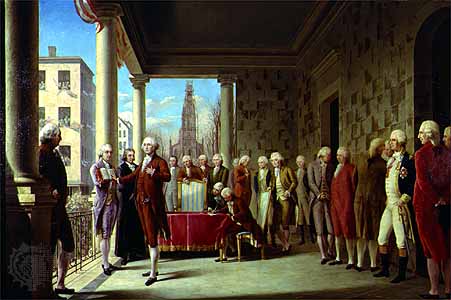Submitting to the requirements of Article II, Section 3 of the United States Constitution, President George Washington stepped in front of the combined membership of the Senate and House of Representatives for his first stand-alone Annual Message — the speech today known as the State of the Union — on January 8, 1790. Addressing Congress in the US’ then-capital of New York City, the former general laid the groundwork for one of the nation’s most anticipated political events each year. Sworn in to the highest office in the land on April 30, 1789, Washington seized on the occasion of his inauguration to deliver the Annual Message required by law. During the intervening eight-plus months, the US began the process of creating a day-to-day government following the principles outlined in the Constitution. In fact, most of the work done by Congress centered on the creation of the Bill of Rights, only sent to the states two months before the President would speak. The balance of power was not yet understood, meaning the political overtones associated with modern incarnations of the State of the Union were much more muddled. Taking the stage on January 8, 1790, Washington presented a series of points encouraging Congress to move quickly in solidifying the young government. His requests, like standardizing currency, fostering a professional military and “the promotion of science and literature” might seem logical today, yet the passage of legislation to fulfill what the President saw as the promise of the new nation was far from certain. Measured and brief, he concluded after just 1,089 words. (By comparison, the 2012 State of the Union address by current President Barack Obama contained more than 7,000.) Over the centuries, the Annual Message has taken on different forms. Thomas Jefferson, the third President, abandoned the idea of an in-person address in 1801. Believing the practice too reminiscent of the Speech from the Throne given throughout the British Empire and in other monarchies, he instead decided to send a formal letter to Congress. Always eager to avoid appearances the President was akin to royalty, Jefferson asked a clerk to read his remarks aloud. Change would not come until Woodrow Wilson stood in the House of Representatives to deliver his first State of the Union in 1913. Ten years later, the importance of the address shifted once again: Calvin Coolidge saw to it the speech was broadcast on the radio throughout the nation. In 1934, Franklin D. Roosevelt changed the name of the Annual Message to the State of the Union, moving the event to the evening hours in 1936 so more people could hear it — a now-standard practice that became official after Lyndon B. Johnson’s famous 1965 State of the Union. Once the speech moved to television in 1947, the possibilities of turning the State of the Union into a presentation of policy ideas blossomed. Some of the most famous words in American history have been uttered from the podium on these nights, such as Johnson’s debut of “The Great Society” programs in 1965 envisioning an America that “asks not how much, but how good” and Abraham Lincoln’s 1862 assertion by “giving freedom to the slave we assure freedom to the free.” Today, the State of the Union is regarded as the President’s chance to lay out his agenda for the coming year in front of those who will attempt to turn it into law or prevent it from doing so. As much an occasion for ceremony as it is a moment to capture the country’s attention, the address has only been canceled once: President Ronald Reagan moved the speech back a week after the Space Shuttle Challenger exploded on the same day he was to enter the House chamber in 1986. Also On This Day: 1780 – Tabriz, Iran is devastated by a 7.7 earthquake, killing some 80,000 people 1867 – African-American men receive the right to vote in Washington, DC 1912 – The African National Congress is founded in South Africa 1918 – President of the United States Woodrow Wilson outlines his “Fourteen Points” for the eventual conclusion of World War I 1994 – Cosmonaut Valeri Polyakov leaves Russia for the Mir space station, beginning a 437-day trip, the longest in history You may also like : January 8 1912 – The African National Congress Is founded In South Africa
January 8 1790 – George Washington Delivers the First State of the Union Address
Submitting to the requirements of Article II, Section 3 of the United States Constitution, President George Washington stepped in front of the combined membership of the Senate and House of…
